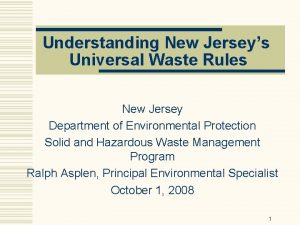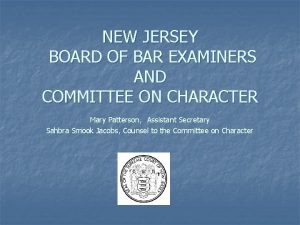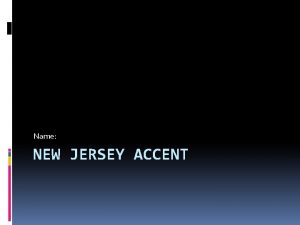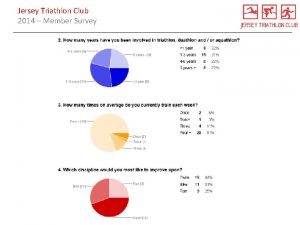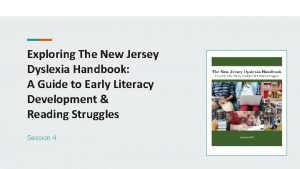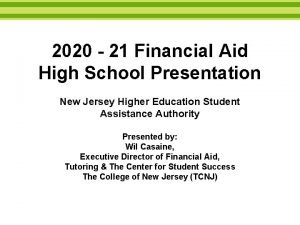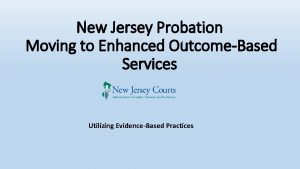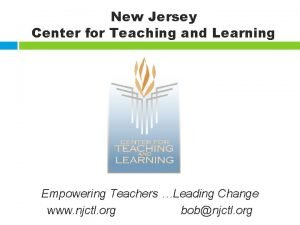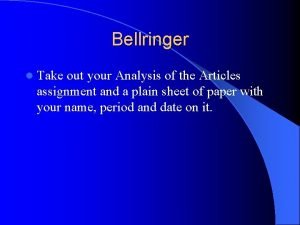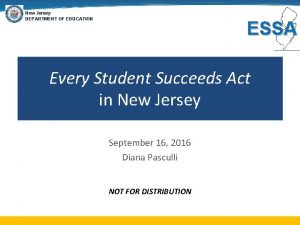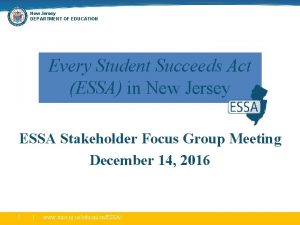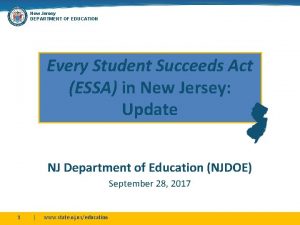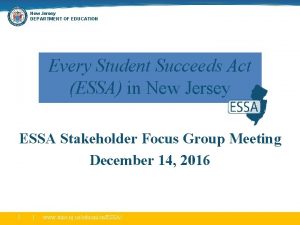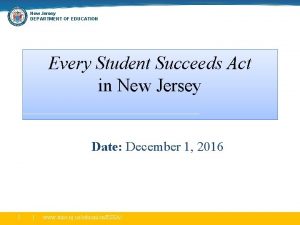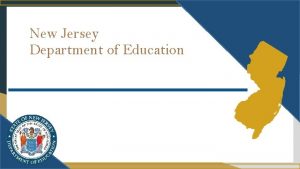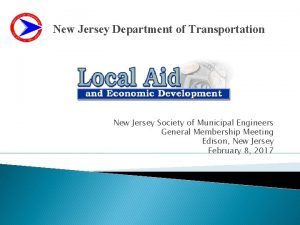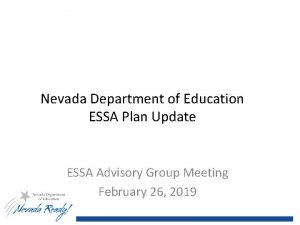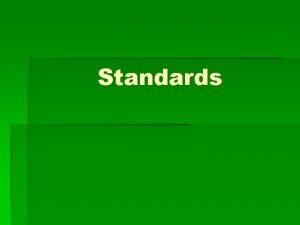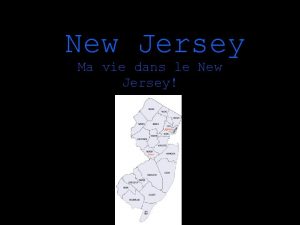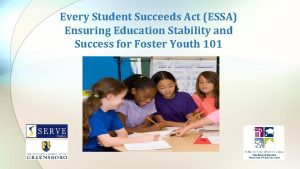New Jersey DEPARTMENT OF EDUCATION ESSA Every Student





















- Slides: 21

New Jersey DEPARTMENT OF EDUCATION ESSA Every Student Succeeds Act in New Jersey September 16, 2016 Diana Pasculli NOT FOR DISTRIBUTION

New Jersey DEPARTMENT OF EDUCATION Every Student Succeeds Act (ESSA) • ESSA, passed December of 2015, replaced No Child Left Behind (NCLB) and is the most recent version of the Elementary and Secondary Education Act (ESEA) • This federal law ensures equitable access to resources and opportunities through three key measures: ‒ Funding ‒ Measuring School Performance and Providing Support ‒ Reporting on School Performance • See our overview video: https: //youtu. be/trm. AF 1 B 8 Za 4 Background 2

New Jersey DEPARTMENT OF EDUCATION Expected Dates for ESSA Activities Date (expected) Federal • Federal regulations and School Year guidance continuously 2016 -17 released State • ESEA Waiver expires (August) • NJ develops and submit state plan in collaboration with stakeholders • Continue to provide targeted support Priority/Focus schools District • Districts spend under No Child Left Behind (NCLB) rules • Priority/Focus school status remains the same as in 2015 -16 Fall 2016 • Final federal regulations posted (expected) • Collaborate with stakeholders to • Districts receive initial spending develop a state plan guidance from NJDOE (Nov) • Ensure state processes, • Districts develop plans in guidance, and data collections collaboration with stakeholders reflect changes from ESSA Spring 2017 • US Department of Education reviews and approves state plans submitted in March or July • Plan to submit state plan to US Department of Education by March 6* following public comment period • Districts continue to receive updated spending guidance from NJDOE • Districts receive allocations from NJDOE and apply for grants • New state plan goes into effect • Districts spend under ESSA rules/formulas School Year 2017 -18 * Subject to change pending final federal regulations Background 3

New Jersey DEPARTMENT OF EDUCATION Engagement Commitment 2016 Jun Jul Aug Sept Oct Nov Dec Jan Feb Mar Apr May Jun 2017 Listening and Learning/Identify Policy Questions Feedback on Specific Proposals/Policies Inform and Explain Implementation Details NJDOE will provide opportunities for interested groups and individuals to: Discuss how NJ state and district may best implement specific areas of existing and new federal law. Build on ongoing community engagement about standards, assessments , educator policies and strategic plan Background Provide targeted feedback, through focus groups and public comment, on NJDOE proposals for initial implementation (201718) and beyond Receive updated and accurate information about implementing ESSA and share best district practices for implementation plans 4

New Jersey DEPARTMENT OF EDUCATION Your Input Matters ESSA offers an opportunity to expand how New Jersey defines a high quality education and to emphasize and reward additional qualities that make for a successful school Parents and Students Professional Organizations Teachers and School Leaders Community • Groups • • 2017 -2018 NJ State Plan to Implement ESSA Background • State Plan Includes: How the state measures and reports on school performance (what factors into a successful school? ); How the state helps struggling schools to better meet the needs of students What the state prioritizes with federal funds; and Much more 5

New Jersey DEPARTMENT OF EDUCATION ESSA Topics Covered in our State Plan Accountability Assessment Supporting Struggling Schools Supporting a Well-Rounded Education (Title IV-A) Supporting Effective Instruction (Title II-A) The Department is seeking input on all the topics above. For today and due to time restraints, we plan to focus on the areas of accountability and supporting effective instruction. 6

New Jersey DEPARTMENT OF EDUCATION Accountability Systems in New Jersey Public Reporting School Performance Reports (Required by state law and practices, and ESEA/ESSA) School-Level District-Level Performance Measures to Quality Single Identify Focus and Priority Accountability Continuum Schools (QSAC) (Required by state law) (Required by ESEA/ESSA) 7

New Jersey DEPARTMENT OF EDUCATION ESSA Public Reporting Requirements ESSA requires states to annually publish report cards on state-, school district-, and schoolperformance. Each school report card must include at least the following measures: Academic Measures • • Academic proficiency and growth on statewide tests, including how each school performed compared to other schools in the district and state Graduation rates Enrollment in pre-school, advanced coursework and post-secondary programs Results on NAEP, if applicable (federal exam for select group of 4 th and 8 th graders nationwide) Quality, Climate, Safety Measures Rates of: • In-school and out-of-school suspensions • Expulsions • School-related arrests • Law enforcement referrals • Chronic absenteeism • Violence incidences (bullying and harassment included) Equity Measures • • Per-pupil expenditures of funds by school Disaggregated by high-poverty compared to lowpoverty schools, the number and percentage of: § Inexperienced teachers, principals, and other school leaders § Teachers with an emergency or provisional certificate § Teachers who are not teaching in the subject or field for which they are certified Performance Reports English Language Proficiency Measures • • The number and percentage of English learners attaining English language proficiency each year The progress of English learners toward achieving the state's goals for achieving English proficiency 8

New Jersey DEPARTMENT OF EDUCATION Performance Reports Timeline 2011 -12 First Reports Released 2015 -16 2016 -17 Release Winter Start 2017; Meet NCLB implementing Waiver ESSA Requirements requirements 2017 -18 Full implementation of ESSA requirements 9

New Jersey DEPARTMENT OF EDUCATION ESSA School-Level Accountability Requirements Accountability Indicators ESEA: 1111(c)(4)(B), Proposed: 34 CFR 200. 14 # Elementary and Middle Schools High Schools Academic Achievement (proficiency) Academic Achievement: Must include proficiency 1 May, at state discretion, include growth Academic Progress (growth or another measure) 2 Graduation rate: Must include 4 -yr adjusted rate May include extended yr adjusted rate Progress Toward English Language Proficiency: Must use progress (growth) 3 May use measure of total or percentage of students reaching English proficiency Progress Toward English Language Proficiency: Must use progress (growth) May use measure of total or percentage of students reaching English proficiency At least one School Quality or Student Success Indicator, which must be: Valid, reliable, and comparable across all LEAs; 4 Calculated in the same way for all schools (except that measures may vary by each grade span) Able to be disaggregated for each subgroup At least one School Quality or Student Success Indicator, which must be: Valid, reliable, and comparable across all LEAs; Calculated in the same way for all schools (except that measures may vary by each grade span) Able to be disaggregated for each subgroup Note: Participation rate on the statewide test must be factored into the state’s accountability system (federal law requires 95% of all students and each subgroup of student to participate in statewide tests) Accountability Section 1111(c) 10

New Jersey DEPARTMENT OF EDUCATION Some Ideas Around School Quality and Student Success Indicator(s) Blue Text = data NJDOE currently has access to Note: data currently collected may not be valid or reliable and may not be able to disaggregate by subgroup Examples • • • Chronic absenteeism Suspension rates Expulsion rates Facilities quality Access to qualified teachers (including para-educators) Access to specialized support personnel (counselors, nurses, etc) • • • Percentage of middle school students enrolled in algebra or geometry Access to resources Internet access Technology quality and access Teacher to student ratio/class size Social-emotional learning • • • Kindergarten readiness College enrollment following HS graduation Career readiness indicators Family and community engagement Access to advanced coursework (including CTE pathways) Sources: 1. Darling-Hammond, Linda et. Al. (2016, Jan 28) Pathways to New Accountability through the Every Student Succeeds Act. Learning Policy Institute and Stanford Center for Opportunity Policy in Education. 2. https: //www. nea. org/assets/docs/Backgrounder-Opportunity%20 Dashboard%20 Indicator. pdf 3. https: //www. acteonline. org/uploaded. Files/Policy_and_Advocacy/Key_Issues/ESSA_Fact_Sheet_Career%20 Readin ess%20 Accountability. pd Accountability 11

New Jersey DEPARTMENT OF EDUCATION Table Discussions 12

New Jersey DEPARTMENT OF EDUCATION Facts Title II, Part A – Supporting Effective Instruction Purpose Increase student achievement by: • Improving the quality and effectiveness of teachers, principals, and other school leaders; • Increasing the number of teachers, principals, and other school leaders who are effective in improving student academic achievement; and • Providing low-income and minority students greater access to effective teachers, principals, and other school leaders How much money does NJ receive? $50 million per year • 95% must go directly to school districts (see distribution below) • Up to 1% may be used for State administration • Up to 4% may be used for State activities Who is eligible to receive funds? All New Jersey School Districts How are funds distributed? • 80% of state’s allocation is distributed based on each school district’s number of students living in poverty • 20% of the state’s allocation is distributed based on each school district’s number of total students Title II-A 13

New Jersey DEPARTMENT OF EDUCATION Changes To Uses of Title II-Part A Funds • ESSA expands how states may use funds to support effective instruction. Examples of newly allowed uses include: ‒ Improving equitable access to effective teachers ‒ Expanding alternate route certification options for teachers in high demand (ex: STEM, English Learner, special education, etc. ) ‒ Training all school staff to prevent and recognize child abuse ‒ Developing high quality, evidence-based STEM, computer science, and blended learning professional development ‒ Optional: may set aside funds specifically for programs and activities to support principals and other school leaders • ESSA establishes stricter guidelines for school districts’ use of funds, including: ‒ Use of funds for class-size reduction: a school district is required to provide evidence to suggest reducing class sizes by a specific amount improves student achievement ‒ Definition of “professional development” that may be paid for federal funds to be (8101(42)): such professional development must be: o Integral to the school and district’s professional development plan o Sustained, intensive, collaborative, and job-embedded (i. e. not stand-alone, 1 -day workshops) Title II-A 14

New Jersey DEPARTMENT OF EDUCATION Table Discussions 15

New Jersey DEPARTMENT OF EDUCATION Continuing the Conversation ESSA • For updated notifications, resources and additional opportunities for engagement, see NJ Department of Education ESSA Website http: //www. state. nj. us/education/ESSA/ • For questions, concerns, recommendations, requests for resources or opportunities to engage, contact NJ ESSA Team: essa@doe. state. nj. us 16

New Jersey DEPARTMENT OF EDUCATION Appendix 17

New Jersey DEPARTMENT OF EDUCATION School Quality and Student Success Indicator(s) Key Questions: • For next two years: in the first year or two of the new accountability system, indicators are limited to those for which data is already collected. With this in mind, which school quality and student success indicator(s) should be included in the accountability system? • In 3 -5 years: when collection of additional data can be established, which other indicators should be included in the accountability system? Limitations: • Law, which requires this indicator(s) to be valid, reliable, and comparable across all school districts • Proposed rules, which would require this indicator(s) to include a measure: § That can be disaggregated by subgroup; and § That research indicates performance on the measure(s) is correlated with positive student outcomes. • Data access, which limits the valid and reliable measures the state may use (if there is no consistent reliable data collection, there is no way for the Department to accurately calculate the indicator) Accountability Section 1111(c)(4)(b) 18

New Jersey DEPARTMENT OF EDUCATION Facts Title I, Part A, Section 1111(b)(2), Academic Assessments Who must take statewide assessments? NCLB 1111(b)(3) All students in required grades State must ensure at least 95% of all students and each subgroup in each school take the assessment Math and English Language Arts (ELA): Each of grades 3 -8; and Once in grades 10 -12 In which grades must students take Science: statewide Once in grades 3 -5; assessments? Once in grades 6 -9; and Once in grades 10 -12 Assessment ESSA 1111(b)(2) All students in required grades State must ensure at least 95% of all students and each subgroup in each school take the assessment Math and English Language Arts (ELA): Each of grades 3 -8; and Once in grades 9 -12 Science: Once in grades 3 -5; Once in grades 6 -9; and Once in grades 10 -12 19

New Jersey DEPARTMENT OF EDUCATION Topics for Discussion ESSA provides a few opportunities regarding assessment: • Assessment system audit • Innovative assessment demonstration authority • Nationally-recognized high school assessments • Target limit on testing time Assessment 20

New Jersey DEPARTMENT OF EDUCATION Impacts to Districts for 2016 -17 • Most elements remain the same as in 2015 -16, including funding formulas/usages, with a few notable exceptions: ‒ No Annual Measurable Objectives (AMO) or Annual Measurable Achievement Objectives (AMAO) required. ‒ Freeze on Focus/Priority schools (no exits). • Note: USED required decision to freeze or create new lists by March 1, 2016; NJ did not have necessary data for evaluating list status by this time and thus had to freeze. The Department will evaluate status of Focus/Priority schools as data becomes available to ensure appropriate recognition and support during ESSA transition time. ‒ No federal Highly Qualified Teacher (HQT) requirement. However, teachers must still be certified. See certification HQT guidance for details 21
 New jersey institute for continuing legal education
New jersey institute for continuing legal education New york pennsylvania new jersey delaware
New york pennsylvania new jersey delaware S sonora
S sonora Universal waste label
Universal waste label New jersey space grant consortium
New jersey space grant consortium Nj driver manual
Nj driver manual Appalachian ridge and valley new jersey
Appalachian ridge and valley new jersey New jersey center for teaching and learning
New jersey center for teaching and learning How many total squares are there
How many total squares are there New jersey board of law examiners
New jersey board of law examiners New jersey accent words
New jersey accent words Jersey triathlon club
Jersey triathlon club Nj dyslexia handbook
Nj dyslexia handbook New jersey plan
New jersey plan New jersey grants & scholarships 2020-21
New jersey grants & scholarships 2020-21 Getting a license illegally may result in
Getting a license illegally may result in Social emotional learning standards nj
Social emotional learning standards nj New jersey courts
New jersey courts New jersey center for teaching and learning
New jersey center for teaching and learning Italiani in new jersey
Italiani in new jersey Njscs
Njscs Virginia plan and new jersey plan venn diagram
Virginia plan and new jersey plan venn diagram



